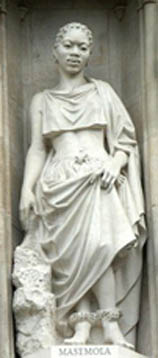Classic DACB Collection
All articles created or submitted in the first twenty years of the project, from 1995 to 2015.Masemola, Manche (A)

I shall be baptized with my own blood. – Manche Masemola
London’s Westminster Abbey is filled with statues of the famous, poets, prelates, and political leaders. Among them, since 1998, is the statue of a simple South African girl, Manche Masemola, who died for her faith at the hands of her non-Christian parents. Born around 1913 in the Transvaal, Manche grew up in a barren and unproductive land left to the African people by their colonizers after the original settlers had been driven from their own farms and pastures. A member of the Pedi ethnic group, she lived with her parents, two older brothers, a sister, and a cousin, working at home and not exposed to a school education. In 1919 an Anglican monk, Fr. Augustine Moeka of the Community of the Resurrection, established a mission in her part of the Transvaal, and Manche and her cousin Lucia attended services there. Soon they began to attend Christian instructional classes twice a week, and their enthusiasm for their new religion grew.[1]
This was a source of stress within the family, however, for her parents feared she would leave them and not marry the person they would select as her husband. Such arranged marriages were a source of wealth to the families who contracted them. Her parents beat her, and the constantly abused child told her sister and cousin she would die at their hands. “Manche’s mother said she would force us to leave the church. She beat Manche every time she returned from church,” the cousin recalled later. Relations worsened, and the mother hid the girl’s clothes so she could not attend Christian instructional classes. On February 4, 1928, her parents led the teenager to a lonely place, where they killed her, burying her by a granite rock on a remote hillside. Her younger sister soon became ill and died, and was buried nearby. Their father planted some trees by the graves.
Small groups of Christians began to visit the gravesite beginning in 1935. In 1969 her mother was baptized, and in 1975 the Church of the Province of Southern Africa added the name of Manche Masemola to its list of heroic Christians marked for special commemoration. Now each year, especially on the first weekend in August, large groups of pilgrims frequent the site where this illiterate but faithful victim of parental abuse is buried.
Over the door of historic Westminster Abbey, a structure dating to at least the fifteenth century, were ten empty niches, set among many sculptures of saints and allegorical figures like Mercy, Truth, Righteousness, and Peace. The abbey clergy decided to honor martyrs of the twentieth century, one of the most violent centuries in human history, by placing representative twentieth-century Christians in this prominent place. Two Africans, Manche Masemola and Archbishop Janani Luwum of Uganda, were selected, along with such heroic figures as Martin Luther King Jr., killed in the United States of America, Oscar Romero, Latin American martyr assassinated for his human rights activity, Dietrich Bonhoeffer of Germany, and Maximilian Kolbe of Poland, both of whom were executed for opposing Hitler. The statues were unveiled by the archbishop of Canterbury and church leaders from many parts of the world. The Rev. Anthony Harvey, subdean of Westminster, wrote, “During this most violent of centuries thousands of men and women have paid with their lives and their convictions. Those represented here have left their testimony to the ultimate cost of Christian witness and to its enduring significance.”
The sparrow has found her a house
and the swallow a nest where she may lay her young;
by the side of your altars, 0 Lord of hosts,
my King and God.
–Psalm 84:2
Frederick Quinn
Notes:
- Andrew Chandler, ed., The Terrible Alternative (London: Cassell, 1998).
This article is reproduced, with permission, from African Saints: Saints, Martyrs, and Holy People from the Continent of Africa, copyright © 2002 by Frederick Quinn, Crossroads Publishing Company, New York, New York. All rights reserved.



